Graffiti is a persistent problem in urban areas, causing aesthetic and economic damage to buildings, bridges, and other public structures. It's not just an eyesore, but also a sign of neglect and lack of community pride. As a business specializing in graffiti removal and vandalism clean-up in London, we've seen firsthand the impact it can have on local businesses and residents. In this article, we'll explore urban design solutions to prevent graffiti and promote a cleaner, safer, and more vibrant urban environment.
Table of Contents
The Causes of Graffiti
Before we dive into the solutions, it's essential to understand the underlying causes of graffiti. Research suggests that graffiti is often a symptom of deeper social and economic issues, such as poverty, lack of opportunities, and social disconnection. Graffiti can also be a form of rebellion, a way for individuals to express themselves and gain recognition. Additionally, the anonymity of urban environments can embolden individuals to engage in vandalism. By addressing these underlying factors, urban designers can create spaces that discourage graffiti and promote positive community engagement.
Designing Out Graffiti
Urban design can play a significant role in preventing graffiti. By incorporating design elements that discourage vandalism, cities can reduce the incidence of graffiti and promote a cleaner, safer environment. Some strategies include:
- Using materials that are difficult to tag, such as rough-textured surfaces or materials with a high-gloss finish.
- Incorporating natural surveillance, such as placing buildings and public spaces in a way that maximizes visibility and minimizes hiding spots.
- Creating active, well-lit public spaces that encourage community engagement and discourage loitering.
- Incorporating public art and murals, which can provide a legitimate outlet for creative expression and reduce the appeal of illegal graffiti.
Lighting as a Deterrent
Lighting is a critical aspect of urban design, and it can play a significant role in preventing graffiti. Well-lit public spaces can discourage vandalism by making it more difficult for individuals to remain anonymous. Additionally, lighting can highlight areas that are prone to graffiti, making it easier for authorities to identify and respond to incidents. Some strategies for using lighting as a deterrent include:
- Installing motion-sensitive lights that activate when someone approaches a potential graffiti hotspot.
- Using high-pressure sodium lights, which are more difficult to tag than traditional fluorescent lights.
- Incorporating lighting into public art installations, which can create a sense of community ownership and reduce the appeal of graffiti.
Urban Greening and Graffiti Prevention
Urban greening initiatives, such as parks, gardens, and green roofs, can also play a role in preventing graffiti. Green spaces can provide a sense of community pride and ownership, reducing the likelihood of vandalism. Additionally, urban greening can improve air quality, reduce noise pollution, and create a more pleasant urban environment. Some strategies for using urban greening to prevent graffiti include:
- Incorporating native plant species that are difficult to damage or destroy.
- Creating green spaces that are accessible and inviting, reducing the appeal of graffiti-prone areas.
- Incorporating public art and community engagement initiatives into urban greening projects, which can foster a sense of community ownership and reduce the incidence of graffiti.
Community Engagement and Education
Community engagement and education are critical components of any graffiti prevention strategy. By educating residents and businesses about the impact of graffiti and the importance of community pride, cities can reduce the incidence of vandalism and promote a cleaner, safer environment. Some strategies for community engagement and education include:
- Organizing community clean-up events and graffiti removal initiatives, which can foster a sense of community ownership and pride.
- Providing education and outreach programs for at-risk youth, which can provide alternative forms of creative expression and reduce the appeal of graffiti.
- Collaborating with local businesses and residents to identify graffiti hotspots and develop targeted prevention strategies.
Technology and Graffiti Prevention
Technology can also play a significant role in preventing graffiti. From surveillance cameras to mobile apps, there are a range of tools and strategies that can help cities reduce the incidence of vandalism. Some strategies for using technology to prevent graffiti include:
- Installing surveillance cameras in graffiti-prone areas, which can provide evidence and deter potential vandals.
- Developing mobile apps that allow residents to report graffiti incidents and track clean-up efforts.
- Using data analytics to identify graffiti hotspots and develop targeted prevention strategies.
Collaboration and Partnerships
Finally, collaboration and partnerships are critical components of any graffiti prevention strategy. By working together with local businesses, residents, and community organizations, cities can develop comprehensive solutions that address the root causes of graffiti and promote a cleaner, safer environment. Some strategies for collaboration and partnerships include:
- Developing public-private partnerships to fund graffiti prevention initiatives and provide resources for clean-up efforts.
- Collaborating with community organizations to provide education and outreach programs for at-risk youth.
- Working with local businesses to identify graffiti hotspots and develop targeted prevention strategies.
Graffiti is a complex problem that requires a multifaceted solution. By incorporating urban design principles, lighting, urban greening, community engagement, education, technology, and collaboration, cities can reduce the incidence of graffiti and promote a cleaner, safer, and more vibrant urban environment. As a business specializing in graffiti removal and vandalism clean-up in London, we've seen firsthand the impact that these strategies can have. By working together, we can create cities that are proud, safe, and beautiful – and where graffiti is a thing of the past.
Frequently Asked Questions
What are the most common types of graffiti?
Graffiti can take many forms, but some of the most common types include tag graffiti, stencil graffiti, sticker graffiti, and mural graffiti. Tag graffiti involves writing or drawing a name or symbol, while stencil graffiti uses a template to create an image. Sticker graffiti involves placing stickers with images or messages, and mural graffiti involves creating larger, more elaborate designs.
Why is graffiti a problem?
Graffiti can be a significant problem for businesses and property owners because it can damage property, create an eyesore, and even contribute to a sense of neglect or disorder in a community. Additionally, graffiti can be costly to remove, and if left unchecked, it can attract more vandalism and crime.
How can urban design help prevent graffiti?
Urban design can play a crucial role in preventing graffiti by incorporating features that discourage vandalism, such as well-lit areas, open sightlines, and limited access to potential graffiti targets. Urban design can also promote a sense of community and ownership, making it less likely that individuals will engage in destructive behavior.
What are some common urban design solutions to prevent graffiti?
Some common urban design solutions to prevent graffiti include installing murals or street art, using graffiti-resistant materials, incorporating natural surveillance, and designing public spaces that are inviting and well-maintained. These solutions can help to reduce the incidence of graffiti and create a more positive, welcoming environment.
How can I prevent graffiti on my business or property?
There are several steps you can take to prevent graffiti on your business or property, including installing security cameras, improving lighting, and using graffiti-resistant coatings or surfaces. You can also work with local authorities and community groups to promote a sense of ownership and responsibility for the area.
What should I do if I find graffiti on my property?
If you find graffiti on your property, it's essential to act quickly to remove it. The longer graffiti remains, the more likely it is to attract additional vandalism. You can contact a professional graffiti removal service, such as Graffiti Removal London, to safely and effectively remove the graffiti.
How do I report graffiti in my area?
If you see graffiti in your area, you can report it to your local authorities or council. They will typically have a process in place for removing graffiti and may be able to provide guidance on how to prevent future incidents.
Can I remove graffiti myself?
While it may be tempting to try to remove graffiti yourself, it's generally not recommended. Graffiti removal requires specialized equipment and techniques to avoid damaging surfaces or causing further harm. A professional graffiti removal service, such as Graffiti Removal London, has the expertise and resources to safely and effectively remove graffiti.
How much does graffiti removal cost?
The cost of graffiti removal can vary depending on the size and complexity of the graffiti, as well as the type of surface it's on. At Graffiti Removal London, we offer competitive pricing and can provide a quote based on your specific needs.
How long does graffiti removal take?
The time it takes to remove graffiti can vary depending on the size and complexity of the graffiti, as well as the type of surface it's on. In general, our team at Graffiti Removal London can remove graffiti quickly and efficiently, often in a matter of hours or days.
Can I prevent graffiti from coming back?
Yes, there are steps you can take to prevent graffiti from coming back. These include installing security cameras, improving lighting, and using graffiti-resistant coatings or surfaces. You can also work with local authorities and community groups to promote a sense of ownership and responsibility for the area.
What are some common graffiti hotspots?
Common graffiti hotspots include train stations, bus stops, public buildings, and alleys or other areas with limited visibility. These areas are often targeted because they are easily accessible and provide a high level of visibility for the graffiti.
How can I protect my business from graffiti?
There are several steps you can take to protect your business from graffiti, including installing security cameras, improving lighting, and using graffiti-resistant coatings or surfaces. You can also work with local authorities and community groups to promote a sense of ownership and responsibility for the area.
What are the legal consequences of graffiti?
The legal consequences of graffiti can vary depending on the jurisdiction and the severity of the offense. In general, graffiti is considered a form of vandalism and can result in fines, community service, or even criminal charges.
How can I get involved in graffiti prevention efforts in my community?
There are several ways to get involved in graffiti prevention efforts in your community, including volunteering with local clean-up initiatives, participating in community arts programs, and working with local authorities to develop graffiti prevention strategies.
What role do community arts programs play in preventing graffiti?
Community arts programs can play a crucial role in preventing graffiti by providing a positive outlet for creative expression and promoting a sense of ownership and responsibility for public spaces. These programs can also help to foster a sense of community and promote social cohesion.
How can I report graffiti to Graffiti Removal London?
If you see graffiti in London, you can report it to us at Graffiti Removal London. We'll work with you to quickly and effectively remove the graffiti and prevent future incidents.
What areas of London do you serve?
We serve all areas of London, including the City of London, Westminster, Camden, Islington, Hackney, Tower Hamlets, and beyond. If you're located in London, we can provide graffiti removal services to help you protect your property.
What sets Graffiti Removal London apart from other graffiti removal services?
At Graffiti Removal London, we're dedicated to providing fast, effective, and environmentally responsible graffiti removal services. Our team has years of experience and uses the latest equipment and techniques to ensure that graffiti is removed safely and completely.
Do you offer any guarantees or warranties?
Yes, we offer a satisfaction guarantee and warranty on our graffiti removal services. If you're not satisfied with the results, we'll work with you to make it right.
How can I get a quote for graffiti removal services?
You can get a quote for graffiti removal services by contacting us at Graffiti Removal London. We'll work with you to understand your needs and provide a competitive quote based on your specific requirements.
What payment methods do you accept?
We accept a variety of payment methods, including credit cards, bank transfers, and cheques. We'll work with you to find a payment method that's convenient for you.
Toby Doherty
Toby Doherty is a seasoned graffiti removal expert with over 20 years of experience in the industry. Throughout his career, Toby has helped countless businesses and property owners in London maintain clean, graffiti-free spaces. His extensive knowledge of graffiti removal techniques, from eco-friendly solutions to advanced technologies like laser cleaning, makes him a trusted authority in the field. Passionate about restoring urban environments, Toby combines his hands-on expertise with a commitment to staying up-to-date on the latest industry trends and innovations. When he’s not out in the field, Toby shares his insights through detailed articles, offering practical advice on everything from graffiti prevention to legal considerations.



